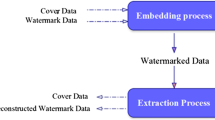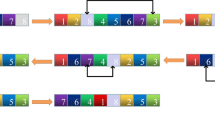Abstract
This paper proposes a self-embedding watermarking scheme that reduces the watermark payload significantly while maintaining good recovery quality and security. The embedded watermark contributes to the tamper detection and content recovery and is composed of only the compression codes of the image content. The compression codes with variable length are generated according to the roughness of the image. To improve the security, a chaos-based pseudorandom sequence generator is adopted to generate block-mapping sequence and encrypt compression codes. The proposed method takes into account the invisibility, recovery quality, and security using the flexible watermark payload, which preserves sufficient information of the image block with as few bits as possible. Experimental results demonstrate that the proposed scheme not only outperforms conventional self-embedding fragile watermarking algorithms in tamper detection and recovery, but also improve the security against the various counterfeiting attacks.







Similar content being viewed by others
References
Chang C-C, Fan Y-H, Tai W-L (2008) Four-scanning attack on hierarchical digital watermarking method for image tamper detection and recovery. Pattern Recogn 41:654–661
Chen F, He H, Huo Y, Wang H (2011) Self-recovery fragile watermarking scheme with variable watermark payload. Proc Int Conf IWDW LNCS 7128:142–155
Fridrich J, Goljan M (1999) Protection of digital images using self-embedding, Proc. Int. Conf. Content Security and Data Hiding in Digital Media
Fridrich J, Goljan M, Memon N (2002) Cryptanalysis of the Yeung-Mintzer fragile watermarking technique. J Electron Imaging 11:262–274
He H, Zhang J, Tai H-M (2009) Self-recovery fragile watermarking using block-neighborhood tampering characterization. Proc Int Conf Inf Hiding Work LNCS 5806:132–145
Huo Y, He H, Chen F (2012) Alterable-capacity fragile watermarking scheme with restoration capability. Opt Commun 285:1759–1766
Lee T-Y, Lin SD (2008) Dual watermark for image tamper detection and recovery. Pattern Recogn 41(2):3497–3506
Lian S, Sun J, Wang J, Wang Z (2007) A chaotic stream cipher and the usage in video protection. Chaos Solitons Fractals 34:851–859
Qian Z, Feng G, Zhang X, Wang S (2011) Image self-embedding with high-quality restoration capability. Digital Signal Process 21:278–286
Qin C, Chang C-C, Chen P-Y (2012) Self-embedding fragile watermarking with restoration capability based on adaptive bit allocation mechanism. Signal Process 92:1137–1150
Yang C, Shen J (2010) Recover the tampered image based on VQ indexing. Signal Process 90:331–343
Zhang X, Wang S, Qian Z, Feng G (2010) Reversible fragile watermarking for locating tampered blocks in JPEG images. Signal Process 90(12):3026–3036
Zhang X, Wang S, Qian Z, Feng G (2011) Reference sharing mechanism for watermark self-embedding. IEEE Trans Image Process 20(2):485–495
Zhang J, Wang X, Zhang W (2007) Chaotic keyed hash function based on feedforward-feedback nonlinear digital filter. Phys Lett A 362:439–448
Acknowledgments
This work is supported in part by the National Natural Science Foundation of China (60970122, 61170226), the Research Fund for the Doctoral Program of Higher Education (20090184120021), and the Fundamental Research Funds for the Central Universities (SWJTU09CX039, SWJTU10CX09)
Author information
Authors and Affiliations
Corresponding author
Rights and permissions
About this article
Cite this article
Chen, F., He, H., Tai, HM. et al. Chaos-based self-embedding fragile watermarking with flexible watermark payload. Multimed Tools Appl 72, 41–56 (2014). https://doi.org/10.1007/s11042-012-1332-5
Published:
Issue Date:
DOI: https://doi.org/10.1007/s11042-012-1332-5




